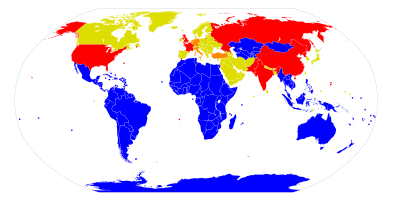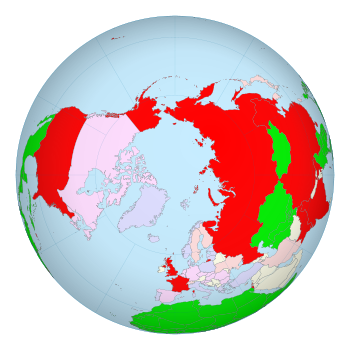- Nuclear-weapon-free zone
-
 Nuclear-Weapon-Free Zones NW states Nuclear sharing NPT only
Nuclear-Weapon-Free Zones NW states Nuclear sharing NPT only
Treaty Region Land area States In force %pop Antarctic Antarctica 14,000,000 km² 1961-06-23 Space Outer Space 1967-10-10 Tlatelolco Latin America
Caribbean21,069,501 km² 33 1969-04-25 Seabed Seabed 1972-05-18 Rarotonga South Pacific 9,008,458 km² 13 1986-12-11[1] Bangkok ASEAN 4,465,501 km² 10 1997-03-28[2] MNWFS Mongolia 1,564,116 km² 1 2000-02-28 Semei Central Asia 4,003,451 km² 5 2009-03-21[3] Pelindaba Africa 30,221,532 km² 53 2009-07-15 All NWFZs combined: 84,000,000 km² 115 39% Nuclear weapons states 41,400,000 km² 9 46% Neither NWS nor NWFZ 24,000,000 km² 68 15% Contents
Definition
A Nuclear-Weapons-Free Zone, or NWFZ is defined[4] by the United Nations as an agreement which a group of states has freely established by treaty or convention, that bans the use, development, or deployment of nuclear weapons in a given area, that has mechanisms of verification and control to enforce its obligations, and that is recognized as such by the General Assembly of the United Nations.
NWFZs do not cover international waters (where there is freedom of the seas) or transit of nuclear missiles through space (as opposed to deployment of nuclear weapons in space).
The NWFZ definition does not count countries or smaller regions that have outlawed nuclear weapons simply by their own law, like Austria with the Atomsperrgesetz in 1999; also, the 2+4 Treaty, at the end of the Cold War, banned nuclear weapons in the six states, which joined to Germany 1990 (area of Berlin and former East Germany), but was an agreement only among the four Allies and two German states.
NWFZs have a similar purpose to, but are distinct from, the Nuclear Non-Proliferation Treaty to which all countries except for four nuclear weapons states are party. Another term, Nuclear-free zone, often means an area which has banned both nuclear power and nuclear weapons, and usually does not mean a UN-acknowledged international treaty.
Coverage of Earth
Today there are five zones covering continental or subcontinental groups of countries (including their territorial waters and airspace), one UN-recognized zone consisting of a single country, Mongolia, and three governing Antarctica, the seabed, and outer space which are not part of any state. The Antarctic, seabed, and space zones preceded all but one of the zones on national territories. Most of the Earth's oceans above the seabed are not covered by NWFZs since freedom of the seas restricts restrictions in international waters.
As of 15 July 2009[update] when the African NWFZ came into force, the six land zones cover 56% of the Earth's land area of 149 million square kilometers and 60% of the 193 states on Earth, up from 34% and 30% the previous year; however only 39% of the world's population lives in NWFZs, while the nine nuclear weapons states have 28% of world land area area and 46% of world population.
 Area in blue is outside exclusive economic zones. Some NWFZs are defined in terms of EEZ areas, though strictly speaking territorial waters extend only 12 nautical miles from land.
Area in blue is outside exclusive economic zones. Some NWFZs are defined in terms of EEZ areas, though strictly speaking territorial waters extend only 12 nautical miles from land.
Boundaries
The Antarctic, Latin American, and South Pacific zones are defined by lines of latitude and longitude, except for the northwestern boundary of the South Pacific zone which follows the limit of Australian territorial waters, and these three zones form a contiguous area, though treaty provisions do not apply to international waters within that area. In contrast, the Southeast Asian zone is defined as the territories of its members including their Exclusive Economic Zones, and the African zone is also defined as the countries and territories considered part of Africa by the OAU (now the African Union) which include islands close to Africa and Madagascar. An AU member, Mauritius, claims the British Indian Ocean Territory where Diego Garcia is currently a US military base.
NWS territories within NWFZs
Nuclear weapons states' territories within NWFZs Treaty Britain France U.S. Tlatelolco Anguilla, Virgin Islands
Caymans, Turks & Caicos
Falklands, South GeorgiaFrench Guiana
Guadeloupe, Martinique
St Barthélemy, St MartinPuerto Rico
Virgin Islands
USMOIRarotonga Pitcairn Island Fr. Polynesia, New Caledonia
Wallis & FutunaAm. Samoa Pelindaba Br. Indian Ocean Territory Réunion, Mayotte, Îles Éparses NWFZs do cover most territories belonging to nuclear weapons states that are situated inside NWFZ boundaries; all are small islands except for French Guiana. However, the U.S. signed but has not ratified Protocol I to the Treaty of Rarotonga which would apply to American Samoa and the U.S. and Britain dispute the African NWFZ's applicability to Diego Garcia which is an American military base.
Countries without nuclear weapons or NWFZ
All countries without nuclear weapons and without a NWFZ are parties to the Non-Proliferation Treaty. (as are all NWFZ member states, and the 5 NPT-sanctioned nuclear weapon states) There have been NWFZ proposals for the Middle East (e.g. Nuclear program of Iran#Nuclear Free Zone in the Mideast and 2009 UN proposal[5]), the Korean Peninsula, Central Europe, South Asia, and the Arctic.[6]
The majority are members of Western collective security alliances, or geographically protected by those alliances:
- NATO members (25) share nuclear umbrella with Britain, France, and the USA
- Other European Union states (Austria, Ireland, Sweden, Finland) are part of the EU's Common Security and Defence Policy
- States surrounded by NATO and EU (Switzerland, Liechtenstein, San Marino, Vatican, Andorra, Bosnia, Montenegro, Macedonia, Serbia and Kosovo).
The above categories cover all European countries west of the former Soviet Union as well as the Baltic states, Turkey, and Canada.
- South Korea and Japan are American allies under its nuclear umbrella.
- Marshalls, Federated States of Micronesia, and Palau are in Compact of Free Association with the USA
24 other Eurasian countries do not have nuclear weapons or an NWFZ:
- 6 Post-Soviet states: Belarus, Ukraine, Moldova, Georgia, Armenia, Azerbaijan
- Arab League outside Africa: 6 Gulf Cooperation Council states, and Yemen, Jordan, Lebanon, Syria, Iraq
- Iran
- 6 South Asian states: Afghanistan, Maldives, Sri Lanka, Bangladesh, Nepal, Bhutan
Southern Hemisphere
 The area between the Equator and 60°S, and between 20°W and 115°E, excluding Africa, Australia and Indonesia and their neighboring islands and waters, is outside the 5 southern NWFZs. A small area of ocean outside the upper right corner of the map, between Indonesia and Australia, is also not in any NWFZ.
The area between the Equator and 60°S, and between 20°W and 115°E, excluding Africa, Australia and Indonesia and their neighboring islands and waters, is outside the 5 southern NWFZs. A small area of ocean outside the upper right corner of the map, between Indonesia and Australia, is also not in any NWFZ.
Australian islands are part of the South Pacific NWFZ but the other oceanic islands in this area are owned by Britain, France, Norway, and Maldives and are the only Southern Hemisphere lands other than East Timor that are not in a NWFZ.Because few prevailing winds cross the Equator, effects of nuclear explosions in the Northern Hemisphere might send less fallout to the Southern Hemisphere. (This fact was used in the book and film On the Beach, although there the Southern Hemisphere eventually succumbs as well.)
The five southern NWFZs cover Southern Hemisphere lands except East Timor which is in the process of joining ASEAN, and islands north of the 60th parallel south, east of the 20th meridian west, and west of the 115th meridian east, but outside of African, Australian or Indonesian territorial waters, which combined have less than 8000 km² of land area, mostly in Kerguelen:
- South Atlantic:
- St. Helena and its dependencies Ascension Island and Tristan da Cunha, a British overseas territory
- Bouvet Island, a Norwegian territory
- Indian Ocean:
- Kerguelen, Crozet, Saint Paul and Amsterdam Islands, some of the French Southern Territories
- Chagos Islands (British Indian Ocean Territory) including Diego Garcia (disputed by Mauritius)
- Addu, the southernmost of the atolls of the Maldives
In 1994 states of the South Atlantic Peace and Cooperation Zone issued a "Declaration on the Denuclearization of the South Atlantic" which the U.N. General Assembly endorsed but the U.S., U.K., and France still opposed.[7]
Northern Hemisphere tropical lands not in a NWFZ Region All of Parts of Pacific Marianas, FSM, Marshalls, Palau Hawaii (all but NW), USMOI Arabia Yemen Saudi Arabia, UAE, and Oman South Asia Maldives, Sri Lanka Peninsular India, Bangladesh China Hainan Yunnan, Guangdong/Xi, Taiwan Tropics
The Latin American, African, South Pacific and Southeast Asian zones also cover most land in the tropics, but not some Northern Hemisphere areas south of the Tropic of Cancer. Most tropical land outside of NWFZs is in India and the Arabian Peninsula.
Little of the land area covered by the five southern Nuclear-Weapon-Free Zones extends north of the Tropic of Cancer: only northern Mexico, northern Bahamas, northern Myanmar, and North Africa. However, the Central Asian and Mongolian zones are entirely in the North Temperate Zone.
Nuclear power and programs
Argentina, Brazil, Mexico, and South Africa, are the only countries in the zones using nuclear power for electricity, with two nuclear plants each. South Africa formerly had a nuclear weapons program which it terminated in 1994.
Argentina and Brazil are known to operate uranium enrichment facilities. Countries that had enrichment programs in the past include Libya and South Africa, although Libya's facility was never operational. Australia has announced its intention to pursue commercial enrichment, and is actively researching laser enrichment.
See also
References
- ^ South Pacific Nuclear Free Zone Treaty [Treaty of Rarotonga]
- ^ SEANWFZ Enters Into Force; U.S. Considers Signing Protocol Arms Control Association, April 1997
- ^ Nuclear free zone in Central Asia enters into force Saturday The Earth Times, 20 March 2009
- ^ Resoulution 3472; Comprehensive study of the question of nuclear-weapon-free zones in all its aspects Resolutions adopted on the reports of the First Committee, United Nations General Assembly 30th session, 2437th plenary meeting, 11 December 1975
- ^ A/RES/64/26 - Establishment of a nuclear-weapon-free zone in the region of the Middle East United Nations General Assembly Sixty-fourth session, 14 January 2010
- ^ "Speech: Robson - Arctic Nuclear Weapons Free Zone". Scoop News. 12 August 2009. http://www.scoop.co.nz/stories/PO0908/S00129.htm.
- ^ Encyclopedia of the United Nations and international agreements: A-F ISBN 9780415939218
External resources
- Nuclear-Weapon-Free Zones Around the World site about NWFZs run by OPANAL, the organization which monitors the Treaty of Tlatelolco
- Oceans in the Nuclear Age:Nuclear-Free Zones from the Law of the Sea Institute at Boalt School of Law (University of California, Berkeley). Includes treaty texts.
- Nuclear Weapons Free Zones Briefing Paper from Atomic Mirror
- UN Pages on Nuclear Weapon Free Zones
- Nuclear Weapon-Free Zones Social Science Research Network, Marco Rossini, 2003
- Arctic Nuclear-Weapon-Free Zone Canadian Pugwash Group's initiative for an Arctic NWFZ
Categories:- Nuclear weapons policy
- Nuclear-weapon-free zones
Wikimedia Foundation. 2010.

